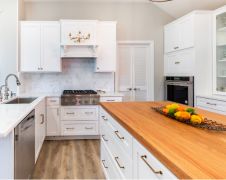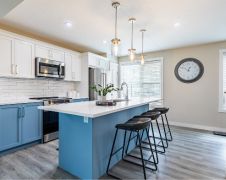Refacing or Painting Kitchen Cabinets: Which Option is Best?
Updating your kitchen cabinets can completely transform the look of your space without the hassle of a full kitchen remodel. However, deciding whether to repaint or reface your cabinets is often a tough decision for homeowners. While both options have their benefits, cabinet refacing offers more significant, lasting advantages. In this article, we’ll break down the pros and cons of each option to help you decide which is best for your kitchen makeover—and why partnering with experts like Kitchen Tune-Up of East Brunswick can make the process seamless.
Understanding the Basics
What is Cabinet Refacing?
Cabinet refacing is a process where the visible parts of your cabinets—such as doors, drawer fronts, and hardware—are replaced, while the existing cabinet framework is covered with a durable and visually appealing veneer. The result is a completely updated, modern appearance without the time and expense of a full kitchen renovation.
Here’s why homeowners love refacing:
- It provides a cost-effective solution to achieving a like-new kitchen.
- It allows for customization with various finishes, colors, and hardware.
- It’s faster and less disruptive than a complete remodel.
Refacing is ideal for homeowners who want a dramatic transformation without the extensive construction work. To learn more, check out our in-depth blog post, "What is Refacing Kitchen Cabinets?."
What is Cabinet Painting?
Cabinet painting involves applying a fresh coat of paint to your existing cabinets to refresh their look. While it’s a relatively simple process, painting often requires significant prep work, including sanding, priming, and multiple coats of paint.
While painting can be a budget-friendly option, it has its limitations:
- Painted cabinets are prone to chipping, peeling, and fading, especially in high-use areas.
- You’re limited to color changes, without the option to update the style or structure.
- The finish may require touch-ups over time, increasing maintenance.
Comparing Refacing and Painting
When choosing between refacing and painting, it’s essential to consider factors like cost, durability, and the visual impact on your kitchen.
Cost Differences
Painting is typically the cheaper option upfront, but it often incurs hidden costs over time due to frequent touch-ups and repainting. On the other hand, cabinet refacing is an investment that pays off in the long run. With materials that are built to last, refacing eliminates the need for ongoing maintenance.
At Kitchen Tune-Up of East Brunswick, we offer high-quality refacing solutions designed to save you time and money in the long term. Investing in refacing today can prevent the need for costly updates down the road.
Longevity and Durability
Refaced cabinets are built to last for decades, making them a durable choice for homeowners who want a lasting solution. In contrast, painted cabinets tend to show wear and tear within just a few years. If you’re looking for a kitchen update that will stand the test of time, refacing is the clear winner.
Want to know more? Check out our detailed guide, "How Long Does Cabinet Refacing Last?"
Visual Impact and Design Options
Refacing provides unmatched customization opportunities. By replacing your cabinet doors and hardware, you can transform the entire aesthetic of your kitchen. Whether you prefer sleek, modern finishes or classic, timeless designs, refacing lets you achieve your vision.
Painting, on the other hand, only changes the cabinet color, leaving the outdated style intact. If you’re looking for a complete design overhaul, refacing offers far more flexibility.
Looking for inspiration? This HGTV article about kitchen cabinet styles and trends shows current cabinet trends. With Kitchen Tune-Up of East Brunswick, staying on-trend has never been easier.
Pros and Cons of Each Option
Pros of Cabinet Refacing
- Sustainable: By reusing the existing cabinet framework, refacing produces far less waste than full replacement.
- Modernized Look: Refacing lets you update your style with new cabinet fronts.
- Durability: The materials used in refacing provide long-term resilience compared to a layer of paint. It’s a great way to get that brand-new kitchen feel without the total renovation price tag.
Check out Better Homes & Gardens' take on refacing and why it's a smart option here: BHG Kitchen Cabinet Refacing.
Cons of Painting
- Shorter Lifespan: Painted cabinets, especially in kitchens with heavy use, are prone to chips and need regular maintenance.
- Limited Design Options: Painting does not allow for a new door style—just a color change.
Key Considerations Before Making a Decision
Budget Analysis
While painting may seem more affordable initially, refacing offers better value over time. With fewer maintenance costs and a longer lifespan, refacing is an investment that pays off. It also adds value to your home, making it a smart choice for homeowners planning to sell. To understand how kitchen remodels impact home value, see this Credit Karma article on How Much Value a Kitchen Remodel Adds.
Aesthetic Goals and Kitchen Condition
If you’re aiming for a complete transformation, refacing is the way to go. It allows you to choose new styles, finishes, and hardware that align with your vision. Painting, while effective for minor updates, doesn’t deliver the same level of impact.
For an in-depth look at refacing’s sustainability benefits, read "9 Essential Tips for Vintage Kitchen Makeovers".
Environmental Impact
Refacing is the more sustainable option, as it involves less waste. Instead of replacing the entire cabinetry, you’re reusing the framework, which means less wood waste and fewer new materials. Painting, while potentially eco-friendly using low-VOC paints, can involve stripping chemicals and other pollutants.
For a more in-depth analysis of refacing's environmental impact, see The Spruce's article: Cabinet Refacing Demystified.
Frequently Asked Questions
- What is the difference between refacing and painting kitchen cabinets?
Refacing and painting are two different approaches to upgrading the look of your kitchen cabinets. Refacing involves replacing the visible components of your cabinets—such as doors, drawer fronts, and hardware—while covering the existing cabinet framework with a durable veneer. This gives your kitchen a brand-new look without the need for extensive construction. Painting, on the other hand, focuses on applying a new coat of paint to your existing cabinets. While it freshens up the color, it doesn’t allow for style changes or upgrades to modern designs.
Refacing also offers greater durability because it uses high-quality materials that resist wear and tear. Meanwhile, painted surfaces are prone to chipping, peeling, and fading over time. If your goal is a complete transformation with minimal maintenance, refacing is the better choice. - Is it cheaper to reface or paint kitchen cabinets?
In the short term, painting is typically less expensive than refacing. However, the initial savings of painting often come with long-term costs. Painted cabinets require regular maintenance, including touch-ups and repainting, which can add up over time. Additionally, the lifespan of a painted finish is much shorter than that of refaced cabinets, meaning you may need to redo the work sooner.
Refacing, while more expensive upfront, is a long-term investment. The high-quality materials and craftsmanship ensure your cabinets will look great and function well for decades. Plus, refaced cabinets can increase your home’s value, making it a smart choice if you’re planning to sell in the future. - How long do refaced cabinets last compared to painted ones?
Refaced cabinets can last for 15 to 20 years—or even longer—when maintained properly. The materials used in cabinet refacing, such as durable veneers and modern hardware, are designed to withstand daily wear and tear. Additionally, the high-quality finishes resist scratches, stains, and fading.
In contrast, painted cabinets often show signs of wear within a few years, especially in high-traffic areas like kitchens. Chipping, peeling, and discoloration are common issues with painted surfaces. While regular maintenance can extend their lifespan, painted cabinets generally don’t last as long as refaced ones. If longevity is your priority, refacing is the better option. - Can I paint cabinets that have already been refaced?
Yes, it’s possible to paint refaced cabinets, but it’s usually unnecessary. Refacing involves replacing your cabinet doors and drawer fronts with new materials, which are often finished with durable, high-quality veneers or laminates. These finishes are designed to last for decades and rarely require additional updates.
However, if you want to change the color of your refaced cabinets in the future, you can apply paint to the veneer or laminate surfaces. Just be sure to use a paint specifically designed for these materials and follow proper preparation steps, such as cleaning and lightly sanding the surface. Keep in mind that painting over refaced cabinets may void any warranties provided by your refacing service.
Refacing: The Smart Choice for Your Kitchen Update
When it comes to updating your kitchen cabinets, refacing offers a cost-effective, durable, and visually impactful solution that stands the test of time. Compared to painting, refacing delivers a complete transformation without the hassle of a full remodel.
If you’re ready to make a lasting change that adds value and beauty to your kitchen, contact Kitchen Tune-Up of East Brunswick today. With our expertise, we’ll guide you through choosing the perfect look for your kitchen—and ensure that your cabinet refacing project is seamless and enjoyable.

